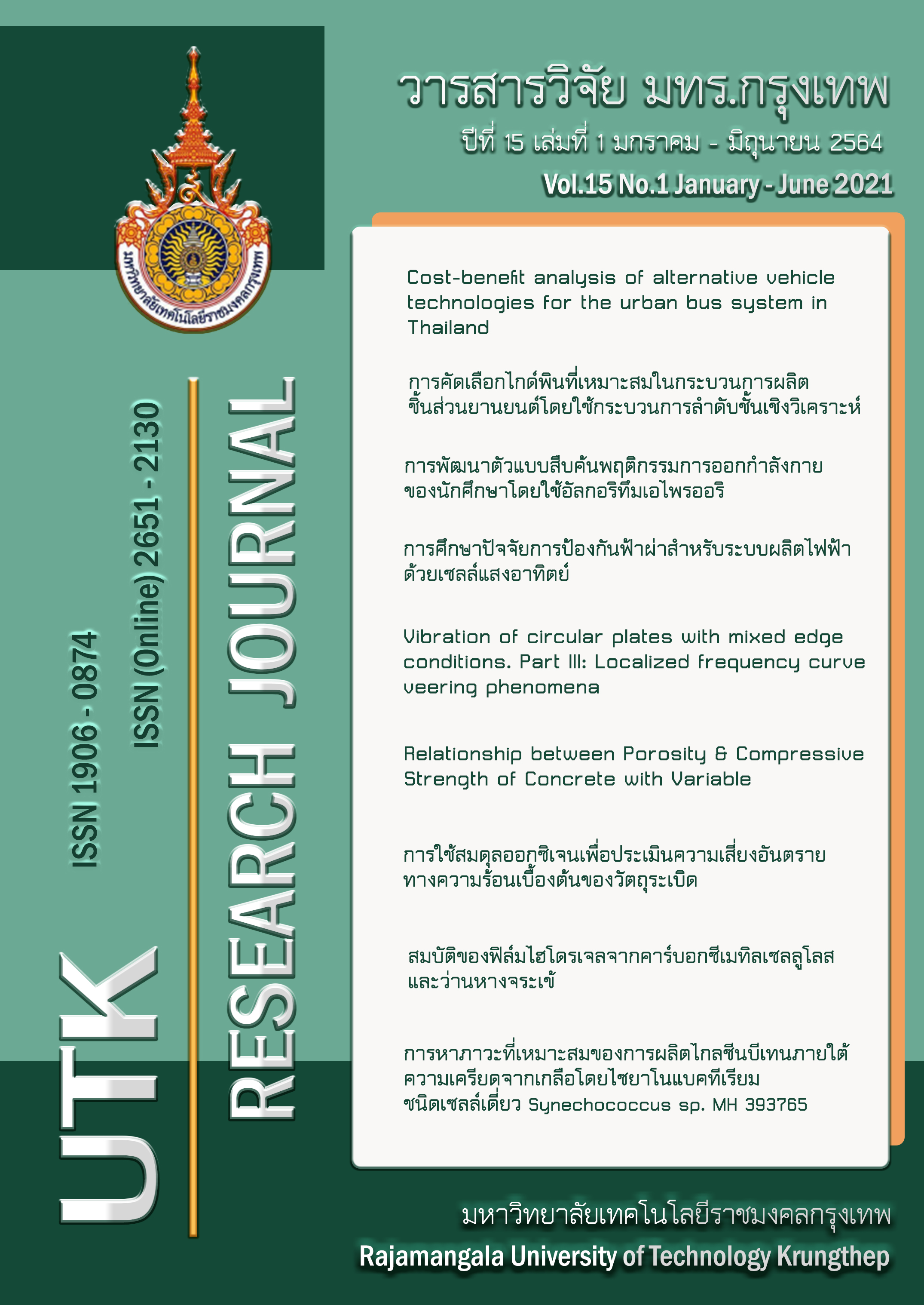สมบัติของฟิล์มไฮโดรเจลจากคาร์บอกซีเมทิลเซลลูโลสและว่านหางจระเข้
คำสำคัญ:
ไฮโดรเจล, คาร์บอกซีเมทิลเซลลูโลส, ว่านหางจระเข้บทคัดย่อ
งานวิจัยนี้มีวัตถุประสงค์เพื่อสังเคราะห์ฟิล์มไฮโดรเจลจากคาร์บอกซีเมทิลเซลลูโลส กับว่านหางจระเข้ โดยใช้ เอ็น,เอ็น-เมทิลลีน-บิส-อะคริลาไมด์ เป็นสารก่อพันธะเชื่อมโยง แอมโมเนียมเพอร์ซัลเฟต เป็นสารริเริ่มปฏิกิริยา และกลีเซอรอลเป็นสารพลาสติไซเซอร์ รวมทั้งศึกษาสมบัติสมบัติเชิงกลและสมบัติการดูดซึมน้ำของแผ่นฟิล์มไฮโดรเจลที่สังเคราะห์ได้ ทดลองโดยแปรผันอัตราส่วนของคาร์บอกซีเมทิลเซลลูโลสกับสารสกัดหยาบจากว่านหางจระเข้ ปริมาณเอ็น,เอ็น-เมทิลลีน-บิส-อะคริลาไมด์ ปริมาณแอมโมเนียมเพอร์ซัลเฟต และปริมาณกลีเซอรอล ผลการทดลองพบว่าภาวะที่เหมาะสมในการเตรียมไฮโดรเจล คือ คาร์บอกซีเมทิลเซลลูโลส: สารกัดหยาบว่านหางจระเข้: เอ็น,เอ็น-เมทิลลีน-บิส-อะคริลาไมด์: แอมโมเนียมเพอร์: กลีเซอรอล ในอัตราส่วน 10: 20: 0.2: 0.2: 1 อบที่อุณหภูมิ 60 องศาเซลเซียส เวลา 6 ชั่วโมง ได้ไฮโดรเจลที่มีความแข็งแรงต่อแรงดึง 0.014±0.004 เมกะพาสคัล ค่าการยืดตัว ณ จุดขาด ร้อยละ 158.2±6.7 การบวมน้ำที่สมดุลร้อยละ 314.66 ± 12.16 และมีปริมาณเจลร้อยละ 34.83 ± 1.45
เอกสารอ้างอิง
Ahmed EM. Hydrogel: Preparation, characterization, and applications: A review. J Adv Res. 2015; 6(2):105–21.
Andrea T, Francesca S, Massimiliano B, et al. Hyaluronan delivery by polymer demixing in polysaccharidebased hydrogels and membranes for biomedical applications. Carbohydr Polym. 2016; 150:408–18.
Yue Y, Han J, Han G, et al. Cellulose nanofibers reinforced sodium alginate-polyvinyl alcohol hydrogels: Coreshell structure formation and property characterization. Carbohydr Polym. 2016;147:155–64.
Lai J-Y, Hsieh A-C. A gelatin-g-poly (N-isopropylacrylamide) biodegradable in situ gelling delivery system for the intracameral administration of pilocarpine. Biomaterials. 2012 ;33(7):2372–87.
Kamoun EA, Kenawy E-RS, Chen X. A review on polymeric hydrogel membranes for wound dressing applications: PVA-based hydrogel dressings. J Adv Res. 2017; 8(3):217–33.
Huang B, Liu M, Zhou C. Chitosan composite hydrogels reinforced with natural clay nanotubes. Carbohydr Polymer. 2017; 175:689–98.
Kudłacik-Kramarczyk S, Drabczyk A, Tyliszczak B. Synthesis of Bees’ Chitosan Based Hydrogels Containing Aloe Vera. Infrastruktura i Ekologia Terenów Wiejskich. 2017;(nr IV/2):1687–98.
Pereira R, Mendes A, Bártolo P. Alginate/Aloe Vera Hydrogel Films for Biomedical Applications. Procedia CIRP. 2013; 5:210–5.
Jung J, Arnold RD, Wicker L. Pectin and charge modified pectin hydrogel beads as a colon-targeted drug delivery carrier. Colloids and Surfaces B: Biointerfaces. 2013 ;104:116–21.
Ortega-Toro R, Collazo-Bigliardi S, Roselló J, et al. Antifungal starch-based edible films containing Aloe vera. Food Hydrocolloids. 2017 Nov 1;72:1–10.
Fekete T, Borsa J, Takács E, et al. Synthesis of carboxymethylcellulose/starch superabsorbent hydrogels by gamma-irradiation. Chem Cent J [Internet]. 2017 May 30 [cited 2018 Mar 6]; 11(1) Available from: https:// www.ncbi.nlm.nih.gov/pmc/articles/PMC5449362/
Kono H. Characterization and properties of carboxymethyl cellulose hydrogels crosslinked by polyethylene glycol. Carbohydrate Polymers. 2014 Jun 15;106:84–93.
Chen XY, Chen C, Zhang ZJ, et al. Nitrogen-Doped Porous Carbon Prepared from Urea Formaldehyde Resins by Template Carbonization Method for Supercapacitors. Ind Eng Chem Res. 2013; 52(30):10181–8.
Zhang T, Li G, Guo L, et al. Synthesis of thermo-sensitive CS-g-PNIPAM/CMC complex nanoparticles for controlled release of 5-FU. Int J Biol Macromol. 2012; 51(5):1109–15.
Hu D, Wang H, Wang L. Physical properties and antibacterial activity of quaternized chitosan/carboxymethyl cellulose blend films. 2016 [cited 2021 Jan 20]; Available from: https://pubag.nal.usda.gov/catalog/5249455
Yadollahi M, Gholamali I, Namazi H, et al. Synthesis and characterization of antibacterial carboxy methyl cellulose/ZnO nanocomposite hydrogels. Int J Biol Macromol. 2015; 74:136–41.
Bajpai SK, Sharma S. Investigation of swelling/degradation behaviour of alginate beads crosslinked with Ca 2+ and Ba2+ ions. Reactive and Functional Polymers. 2004;2(59):129–40.
Mishra R, Banthia A, Majeed A. Pectin based formulations for biomedical applications: A review. Asian J Pharmaceut Clin Res. 2012; 5:1–7.
Ni Y, Turner D, Yates KM, et al. Isolation and characterization of structural components of Aloe vera L. leaf pulp. International Immunophar macology.2004; 4(14):1745–55.
Ni Y, Yates KM, Zarzycki R. Aloe pectins [Internet]. US5929051A, 1999 [cited 2021 Jan 23]. Available from: https://patents.google.com/patent/US5929051A/en
Gupta VK, Malhotra S. Pharmacological attribute of Aloe vera: Revalidation through experimental and clinical studies. AYU (An international quarterly journal of research in Ayurveda). 2012; 33(2):193.
Sharma A, Gautam S. An overview on medicinal properties of aloe vare antibacterial & antifungal aspects [Internet]. undefined. 2013 [cited 2021 Jan 23]. Available from:/paper/An-overview-on-medicinal-properties-of-aloe-vera%3A-%26
Tanaka M, Misawa E, Yamauchi K, et al. Effects of plant sterols derived from Aloe vera gel on human dermal fibroblasts in vitro and on skin condition in Japanese women. Clin Cosmet Investig Dermatol. 2015;8:95–104.
คณะแพทยศาสตร์โรงพยาบาลรามาธิบดี มหาวิทยาลัยมหิดล. สาระน่ารู้ด้านการแพทย์สาธารณสุข ประโยชน์ของว่านหางจระเข้ [Internet]. 2015 [cited 2021 Jan 22]. Available from: https://med.mahidol.ac.th/th/knowledge_awareness_health/11042015-1440-th
Singh S, Anjum S, Joy J, et al. Polysaccharide-Aloe vera bioactive hydrogels as wound care system. in: mondal MdIH, editor. Cellulose-Based Superabsorbent Hydrogels [Internet]. Cham: Springer International Publishing; 2019 [cited 2021 Jan 23]; p. 1473–90. (Polymers and Polymeric Composites: A Reference Series). Available from: https://doi.org/10.1007/978-3-319-77830-3_48
ณัฏฐ์ธวดี จินาพันธ์, เจิมขวัญ สังข์สุวรรณ, สุทธิรา สุทธสุภา, สุฐพัศ คําไทย. คุณสมบัติของฟิล์มคาร์บอกซีเมทิลเซลลูโลสจากเยื่อฟางข้าว. วารสารวิทยาศาสตร์เกษตร. 2555; 43(3 (พิเศษ)):615–20.
D20 Committee. Test Method for Tensile Properties of Thin Plastic Sheeting [Internet]. ASTM International; [cited 2021 Jan 24]. Available from: http://www.astm.org/cgi-bin/resolver.cgi? D882-18
Kokabi M, Sirousazar M, Hassan ZM. PVA–clay nanocomposite hydrogels for wound dressing. 2007.
Zhang J-T, Zhuo R-X, Chu C. Synthesis and properties of thermosensitive, crown ether incorporated poly(N-isopropylacrylamide) hydrogel. Polymer. 2002; 43:4823–7.
Sothornvit R, Olsen CW, Mchugh T, et al. Formation conditions, watervapor permeability, and solubility of compression molded whey protein films. J Food Sci. 2003; 68:1985–99.
สุจัยพรรณ เข็มแก้ว, สุปราณี แก้วภิรมย์. ผลของกลีเซอรอล และเพค-10 ไดเมทิโคนต่อสมบัติของฟิล์มชีวภาพ จากเปลือกทุเรียน. วารสารวิชาการเทคโนโลยีอุตสาหกรรม. 2016; 12(2):11–21.
Ebrahimi B, Mohammadi R, Rouhi M,et al. Survival of probiotic bacteria in carboxymethyl cellulosebased edible film and assessment of quality parameters. LWT - Food Science and Technology. 2017 Aug 1;87.
El.Shafei A, Abou-Okeil A. ZnO/carboxymethyl chitosan bionano-composite to impart antibacterial and UV protection for cotton fabric. Carbohydrate Polymers. 2011; 2(83):920–5.
ชัยวุฒิ วัดจัง. ผลของอัตราส่วนยางและแป้งต่อสมบัติของไฮโดรเจลชนิดพอลิเมอร์เชื่อมขวางแบบกึ่งโครงร่างตาข่ายและการประยุกต์ใช้ในการปลูกดาวเรือง. วารสารวิทยาศาสตร์และเทคโนโลยี มหาวิทยาลัยอุบลราชธานี. 2560; 19(1):49–62.
จตุพร ประทุมเทศ, วริษฎา ศิลาอ่อน, ชัยวัฒน์ วัดจัง, อุษณา พัวเพิ่มพูลศิริ. ผลของแป้งต่อคุณลักษระของไฮโดรเจลที่เตรียมได้จากยางธรรมชาติ. วารสารเภสัชศาสตร์อีสาน. 2013; 9(1).
ชัยวุฒิ วัดจัง, อุมาพร ไชยสุวรรณ, อุไรวรรณ พันธุ์แก่น และคณะ. ผลของสารเชื่อมขวางต่อสมบัติของไฮโดรเจลเชื่อมโยงแบบกึ่งโครงร่างตาข่ายของยางธรรมชาติและแป้งมันสำปะหลัง. วารสารมหาวิทยาลัยทักษิณ. 2013; 16(3):131–8.
Akhtar MF, Hanif M, Ranjha NM. Methods of synthesis of hydrogels. A review. Saudi Pharmaceutical Journal. 2016; 24(5):554–9.
Basiak E, Lenart A, Debeaufort F. Effect of starch type on the physico-chemical properties of edible films. Int J Biol Macromol. 2017 May 1;98:348–56.
Wong R, Ashton M, Dodou K. Effect of Crosslinking Agent Concentration on the Properties of Unmedicated Hydrogels. Pharmaceutics. 2015; 7(3):305–19.
ดาวน์โหลด
เผยแพร่แล้ว
รูปแบบการอ้างอิง
ฉบับ
ประเภทบทความ
สัญญาอนุญาต
กองบรรณาธิการวารสารวิชาการ มหาวิทยาลัยเทคโนโลยีราชมงคลกรุงเทพ มีความยินดีที่จะรับบทความจากอาจารย์ นักวิจัย นักวิชาการทั้งภายในและภายนอกมหาวิทยาลัย ในสาขาวิชาวิทยาศาสตร์และเทคโนโลยี ได้แก่ สาขาวิชาวิทยาศาสตร์ วิศวกรรมศาสตร์ และสาขาอื่นๆ ที่เกี่ยวข้อง รวมถึงสาขาต่างๆ ที่มีการบูรณาการข้ามศาสตร์ที่เกี่ยวข้องวิทยาศาสตร์และเทคโนโลยี ที่เขียนเป็นภาษาไทยหรือภาษาอังกฤษ ซึ่งผลงานวิชาการที่ส่งมาขอตีพิมพ์ต้องไม่เคยเผยแพร่ในสิ่งพิมพ์อื่นใดมาก่อน และต้องไม่อยู่ในระหว่างการพิจารณาของวารสารอื่น
การละเมิดลิขสิทธิ์ถือเป็นความรับผิดชอบของผู้ส่งบทความโดยตรง บทความที่ได้รับการตีพิมพ์ต้องผ่านการพิจารณากลั่นกรองคุณภาพจากผู้ทรงคุณวุฒิและได้รับความเห็นชอบจากกองบรรณาธิการ
ข้อความที่ปรากฏอยู่ในแต่ละบทความที่ตีพิมพ์ในวารสารวิชาการเล่มนี้ เป็นความคิดเห็นส่วนตัวของผู้เขียนแต่ละท่าน ไม่เกี่ยวข้องกับมหาวิทยาลัยเทคโนโลยีราชมงคลกรุงเทพแต่อย่างใด ความรับผิดชอบด้านเนื้อหาและการตรวจร่างบทความแต่ละบทความเป็นของผู้เขียนแต่ละท่าน หากมีความผิดพลาดใดๆ ผู้เขียนแต่ละท่านจะต้องรับผิดชอบบทความของตนเองแต่ผู้เดียว
กองบรรณาธิการขอสงวนสิทธิ์มิให้นำเนื้อหา หรือข้อคิดเห็นใดๆ ของบทความในวารสารวิชาการ มหาวิทยาลัยเทคโนโลยีราชมงคลกรุงเทพ ไปเผยแพร่ก่อนได้รับอนุญาตจากกองบรรณาธิการ อย่างเป็นลายลักษณ์อักษร ผลงานที่ได้รับการตีพิมพ์ถือเป็นลิขสิทธิ์ของวารสาร






